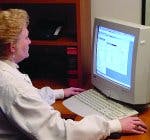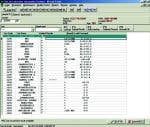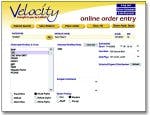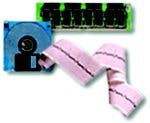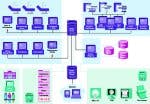To achieve measurable clinical and business outcomes, healthcare professionals need strategic information management for making better decisions, reducing operational costs, and increasing market share. Laboratories rely on validation, accountability, speed and tracking to meet stringent regulatory requirements, and to maximize ever-dwindling reimbursements. Stability, storage, speed
LAB/HEX is a complete LIS for independent, commercial, clinics, hospitals and research labs. All routine lab tasks are managed, including order entry, result entry, barcodes, microbiology, cytology, user-definable reports, autofaxing, remote printing and analyzer interfaces, to name a few. Integrated billing, HIS and practice management interfaces are available. Additional options include ad hoc reporting, document scanning, advanced pathology with voice recognition, electronic billing, medical necessity, and reference lab interfaces. All products are robust, stable and flexible, and can easily and readily be adapted to any application and laboratory. Large labs will find maximum growth capabilities simply by adding more workstations, analyzers, printer and users. Storage and speed can be increased as needed. LAB/HEX
HEX Laboratory Systems
www.rsleads.com/301ml-174Data 247, no downtime
HEX Laboratory Systems
www.rsleads.com/301ml-174Data 247, no downtime
Polytech for Windows is a complete LIS designed by laboratorians for laboratorians. Ninety percent of technician work is performed in one screen, so there are no wasted movements. Utilization of the Medlink redundant database topology means no downtime. All data are available all of the time. The laboratory workflow is automated, while streamlining test processing and regulatory compliance. The system is simple, easy, affordable and flexible. ICD-9 coding and advance beneficiary notice (ABN) generation is standard, as are host-query capabilities and ad hoc reporting, along with rules logic. The product interfaces to all major analyzers and medical information systems.Polytech
Comp Pro Med Inc.
www.rsleads.com/301ml-178Serving small to high-volume labs
Comp Pro Med Inc.
www.rsleads.com/301ml-178Serving small to high-volume labs
Triple G Systems Group Inc. is a global provider of software for the clinical laboratory, ranging from a single facility to integrated networks spanning multiple facilities and wide geographic areas. The company develops and implements software ULTRA, for high-volume distributed lab operations, and NT-based TriWin, serving small to medium-size laboratories that automates and integrates laboratory processes in the hospital, clinic and private reference laboratory settings. ULTRA is a comprehensive LIS for the management and automation of all areas, including identification, tracking and routing of specimens, managing workflow and aggregating test results across sites and platforms. All its modules are fully integrated, allowing users complete access throughout the system. ULTRA
Triple G Systems
www.rsleads.com/301ml-181Marketing to physicians
Triple G Systems
www.rsleads.com/301ml-181Marketing to physicians
With ClinLabs LIS, lab managers not only have the opportunity to increase the technologists efficiency, but automate other office functions, as well. A customer overview of the system delineates a variety of benefits. Lost charges can be eliminated and revenue increased. Less time is spent searching through file cabinets and logs. Writing and rewriting patient demographics on sample logs, requisitions, result slips and send-out logs are eradicated. Transcription errors no longer exist. All patient information can be accessed in seconds; and physician and nursing staff can view verified patient results anywhere, anytime. Billing summaries and ICD-9/CPT checks aid with correct billing of tests. LIS reports help ensure correct reimbursement for all lab tests is received on the first submission. Recoding is diminished or completely ended. Workload analysis reports help evaluate efficiency, while utilization analysis helps highlight profitable services. Flexible reporting and faxing capabilities help market lab services to outside physicians. LIS
Clinlab
www.rsleads.com/301ml-176Q&A storage
Clinlab
www.rsleads.com/301ml-176Q&A storage
LabNet LIS is a Windows NT client server system that marries ease-of-use with versatility, power and high-speed volume. The system seamlessly interfaces with electronic medical records, billing, hospital information systems and practice management systems. Version 5.12 was recently introduced, which includes a separate section for those reference lab tests that require questions and answers, that information can be entered prior to testing and stored indefinitely. Version 5.12 add-on modules work to streamline operations. The advanced reporting module helps managers simplify key complex, day-to-day business functions of
lab administration. This module features an automatic report generation and distribution function that captures data stored in the LIS and automatically sends a particular report to a designated location at a specified time relieving the lab manager of this responsibility.Its Velocity Web module is a simple point-and-click system that embodies the look, feel and navigational flexibility of the Internet. Featuring multilevel security components, Velocity calls up data directly from the LIS, allowing remote locations to check patient results, order lab tests, access patient demographics, schedule patient draws and review pending results. LabNet
LabSoft
www.rsleads.com/301ml-177ASP offers varied modules
LabSoft
www.rsleads.com/301ml-177ASP offers varied modules
ASP users have complete access to LabWeb, a comprehensive clinical LIS which permits the creation like its model, the World Wide Web of various pages of information with a graphical browser, LabWeaver, for their display. With its various button/tool configurations, the right set of operations for particular users means an admitting clerk, a technologist, or a manager would see different configurations. Aside from LabWebs secure environment, users can also avoid having a computer to maintain. Modules available include microbiology, blood bank, and physician results reporting. The PULSAR feature automatically transmits to a local printer, while the ARC feature automatically faxes via telephone lines. Its report-generating program, FILLIN, not only prints patient demographics and test results, but sorts and selects data by any demographic element. Preprinted, user-defined forms with an unlimited number of customized report formats exist, with results always printed in correct form for the physician or the client.LabWeb
Psyche Systems
www.rsleads.com/301ml-179Solution clusters The NOVIUS LIS system, part of a family of solution clusters, operates in nursing homes, physicians offices, and hospital and reference labs. Transport lists can route different specimens to various labs. All samples, no matter their location in the enterprise, can be tracked. Its clinical rules assist in making recommendations for further testing. Technologists can use intuitive online microbiology work cards to review culture history and record test results. Consolidated reporting capabilities include results for all lab work, regardless of where it was performed. Physician customers can access the clinical repository for an enterprise-wide medical records, which can be accessed via the Internet. Browser-enabled software permits off-site healthcare providers or multiple locations to access patient results, medications, and allergies or to check orders. NOVIUS
Siemens Medical Solutions
Healthcare Services Corp.
www.rsleads.com/301ml-180Archival data generation
Psyche Systems
www.rsleads.com/301ml-179Solution clusters The NOVIUS LIS system, part of a family of solution clusters, operates in nursing homes, physicians offices, and hospital and reference labs. Transport lists can route different specimens to various labs. All samples, no matter their location in the enterprise, can be tracked. Its clinical rules assist in making recommendations for further testing. Technologists can use intuitive online microbiology work cards to review culture history and record test results. Consolidated reporting capabilities include results for all lab work, regardless of where it was performed. Physician customers can access the clinical repository for an enterprise-wide medical records, which can be accessed via the Internet. Browser-enabled software permits off-site healthcare providers or multiple locations to access patient results, medications, and allergies or to check orders. NOVIUS
Siemens Medical Solutions
Healthcare Services Corp.
www.rsleads.com/301ml-180Archival data generation
CyberLAB, a scalable LIS, gives technicians the information management tools needed to adhere to applicable HIPAA and other regulatory requirements. Features may include multisite functionality, anatomic pathology, parameterized clinical reports, quality control and historical sample tracking with user identification and accountability. Many features support front-end processing of lab results. Resulting processes allow for timely verification and validation of patient data. Users are alerted when an invalid or incorrect ICD-9 code is assigned to a test on a sample. The system automatically generates the user-defined ABN at the time of order. Remote access via the Internet (or intranet) allows patient data to be securely accessed and tracked from virtually anywhere in the world. Autodial/fax capabilities transmit automatically, based on each caregivers need for specific times of the day, different locations and/or phone numbers, to facsimile or printer. Archived data may be accessed for clinical reporting and inquiry, as well as ad hoc statistical reports, and pending reports, result logs and statistical reports may be generated at any time of day, for any time period.CyberLAB
CCA
www.rsleads.com/301ml-175Web technology interface
CCA
www.rsleads.com/301ml-175Web technology interface
IntelliLabs IMPAC Multi-ACCESS oncology management functionality extends to include a full-featured LIS with advanced Web technology interface to virtually any laboratory device, meaning orders can be placed and results viewed or printed via the Internet. Upon lab order placement, the product verifies if the test qualifies as medically necessary according to the LMRP. If not, the system automatically prepares one or more ABNs. Because rules can also be defined to manage test ordering based on payer contracts, the right test based on the patients insurance is ordered, and ensuing charge capture capabilities with correct use of CPT modifiers and intelligent charge interfaces reduce submission errors and increase reimbursements. Lab results flowing directly from instruments to the LIS/EMR can be immediately reviewed prior to chemotherapy administration. Each patients complete test history is quickly accessible in multiple formats, facilitating review and analysis; and the Multi-ACCESS EMR allows review and analysis of lab results as an integral part of treatment records. An optional imaging module permits images, such as blood smears, to be acquired and managed along with test results. Redundant storage ensures that results will be processed even during a network or system outage. In addition to HL7 standards, IntelliLab complies with CLIA standards for incident tracking and reporting, eliminating the need for paper logs. Multi-ACCESS
IntelliLab
www.rsleads.com/301ml-183 Selecting an LISPrioritize needs early. Determine what is needed in a system. Purchasing an LIS may be a long-term commitment. Cost is not an indicator of quality, performance or value. Understand all requirements. Quantify the benefit from each feature on paper. How much money will the feature save over time, and how would the feature help? Discuss automation needs with lab managers with automation in place. Find out what critical issues they confront with automation.What current major problem areas does the staff want solved?Determine future needs. How many samples will the lab be processing? What type of instrumentation will technicians be using? Consider these questions two, three, or as many as five years from now.Analyze the labs behavioral components. How do things work? How would staff like for them to work? Take an objective view of the lab, evaluating how orders are generated/communicated to the lab; how patient samples are delivered/labeled; how specimens are accessioned/prepared; how testing is accomplished; and how results are communicated back to the nurses/physicians?What computer hardware platforms are in place now? Will a change be likely in the next five years? Will the current host system be replaced in the next few years? How many samples are processed on average per day? How does this segment into various departments? What portions need to be reported from a central LIS, and what portions must be processed via handwriting? Are interfaces to an instrument needed? An interface to a host system? Remote printers or fax (reports sent to doctors offices)? Interfaces to other laboratories? Reports to be printed immediately on completion? What other interfaces will be needed in the future?Prioritize these wants according to what features are needed immediately, which features can be delayed
for the future, and which features would be a bonus. Courtesy of Clinlab
January 2003: Vol. 35, No. 1
IntelliLab
www.rsleads.com/301ml-183 Selecting an LISPrioritize needs early. Determine what is needed in a system. Purchasing an LIS may be a long-term commitment. Cost is not an indicator of quality, performance or value. Understand all requirements. Quantify the benefit from each feature on paper. How much money will the feature save over time, and how would the feature help? Discuss automation needs with lab managers with automation in place. Find out what critical issues they confront with automation.What current major problem areas does the staff want solved?Determine future needs. How many samples will the lab be processing? What type of instrumentation will technicians be using? Consider these questions two, three, or as many as five years from now.Analyze the labs behavioral components. How do things work? How would staff like for them to work? Take an objective view of the lab, evaluating how orders are generated/communicated to the lab; how patient samples are delivered/labeled; how specimens are accessioned/prepared; how testing is accomplished; and how results are communicated back to the nurses/physicians?What computer hardware platforms are in place now? Will a change be likely in the next five years? Will the current host system be replaced in the next few years? How many samples are processed on average per day? How does this segment into various departments? What portions need to be reported from a central LIS, and what portions must be processed via handwriting? Are interfaces to an instrument needed? An interface to a host system? Remote printers or fax (reports sent to doctors offices)? Interfaces to other laboratories? Reports to be printed immediately on completion? What other interfaces will be needed in the future?Prioritize these wants according to what features are needed immediately, which features can be delayed
for the future, and which features would be a bonus. Courtesy of Clinlab
January 2003: Vol. 35, No. 1
About the Author
Sign up for our eNewsletters
Get the latest news and updates

